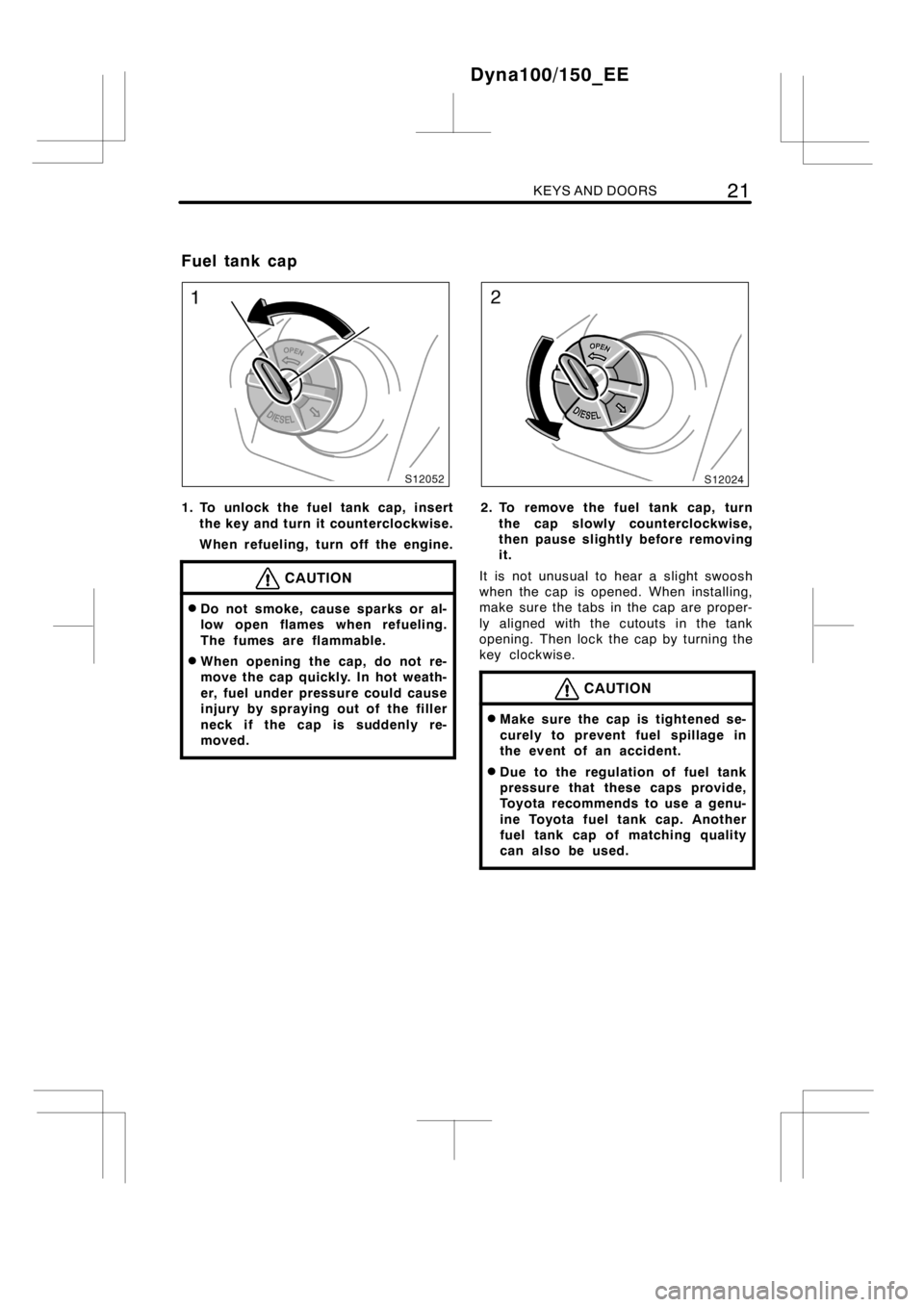Page 24 of 240
18KEYS AND DOORS
Before tilting the cab, observe the fol-
lowing.
1. Park the vehicle on a level ground.
2. Set the parking brake firmly.
3. Put the transmission in neutral.
4. Stop the engine.
5. Remove or secure all the loose items
in the vehicle.
6. Close the doors.
CAUTION
Make sure that no one is around and
in the cab.
NOTICE
Make sure that there is no interfering
object on and in front of the cab.
�: See “Model code” on page vi in the
beginning of this manual if you are not
sure of your vehicle model.
Handle latch lever
Cab lock
handle
1. Pull the cab lock handle up while
holding the handle latch lever up,
and the cab will spring up slightly.
Dyna100/150_EE
Tilt cab—
(single cab models�)—Tilting the cab
Page 25 of 240
KEYS AND DOORS19
Safety
catch lever
Cab stay
lock lever
2. Hold the cab down, pull the safety
catch lever out and raise the cab to
tilt forward. Make sure that the cab
stay lock lever locks securely.
The cab will automatically lock when it
tilts fully forward.
CAUTION
When the cab tilts fully forward, make
sure the cab stay lock lever securely
locks and that the cab does not low-
er.
Cab stay lock
lever stopper
3. Plug the opening with the cab stay
lock lever stopper for additional se-
curity.
CAUTION
When tilting the cab, make sure that
the cab stay lock lever stopper has
immobilized the cab stay lock lever.
If it is not immobilized, the cab could
lower and cause death or serious in-
juries.
Dyna100/150_EE
Page 26 of 240
20KEYS AND DOORS
1. Pull the cab stay lock lever stopper
up and return it to the upper hole.
While holding the cab with the grip,
pull the cab stay lock lever up to
unlock, then lower the cab slowly.
Before lowering the cab, check to see that
you have not forgotten any tools, rags,
etc.
CAUTION
When lowering the cab, make sure
that no one is around the cab.
2. Press down the cab lock handle
firmly.
Make sure the cab is securely locked.
CAUTION
Do not drive the vehicle without lock-
ing the cab securely. Otherwise, the
cab may be tilted unexpectedly, possi-
bly causing an accident.
Dyna100/150_EE
—Lowering the cab
Page 27 of 240

KEYS AND DOORS21
1. To unlock the fuel tank cap, insert
the key and turn it counterclockwise.
When refueling, turn off the engine.
CAUTION
DDo not smoke, cause sparks or al-
low open flames when refueling.
The fumes are flammable.
DWhen opening the cap, do not re-
move the cap quickly. In hot weath-
er, fuel under pressure could cause
injury by spraying out of the filler
neck if the cap is suddenly re-
moved.
2. To remove the fuel tank cap, turn
the cap slowly counterclockwise,
then pause slightly before removing
it.
It is not unusual to hear a slight swoosh
when the cap is opened.When installing,
make sure the tabs in the cap are proper-
ly aligned with the cutouts in the tank
opening. Then lock the cap by turning the
key clockwise.
CAUTION
DMake sure the cap is tightened se-
curely to prevent fuel spillage in
the event of an accident.
DDue to the regulation of fuel tank
pressure that these caps provide,
Toyota recommends to use a genu-
ine Toyota fuel tank cap. Another
fuel tank cap of matching quality
can also be used.
Dyna100/150_EE
Fuel tank cap
Page 28 of 240
22KEYS AND DOORS
Dyna100/150_EE
Page 53 of 240

SEATS, SEAT BELTS, STEERING WHEEL AND MIRRORS47
Provided information in the table shows your child restraint system suitability for various
seating positions. This table is applicable to only EU countries.
Front seat Rear seat
Passenger
seatCenter Outside
0
Up to 10 kg (22 lb.)
(0—9 months)
0
+
Up to 13 kg (28 lb.)
(0—2 years)
I
9to18kg
(20to39lb.)
(9 months—4 years)
II, III
15 to 36 kg
(34to79lb.)
(4—12 years)
Seating position
Mass groups
L1
L1
L3X
X
X
XU
U
U
U L2Center
X
X
UF
UF
Key of letters inserted in the above table:
U: Suitable for “universal” category child restraintsystemapproved for the use in this
mass group
UF: Suitable for forward−facing “universal” category child restraintsystemapproved for
the use in this mass group
L1: Suitable for “TOYOTA BABYSAFE (0 to 13 kg)” approved for the use in this mass
group
L2: Suitable for “TOYOTA DUO (without ISOFIX, 9 to 18 kg)” approved for the use in
this mass group
L3: Suitable for “TOYOTA KID (15 to 36 kg)” approved for the use in this mass group
X: Not suitable seat position for children in this mass group
Other child restraint system which is different from the system mentioned in the table
can be used, but the suitability of the systems must be carefully checked with the child
restraint system manufacturer concerned and the seller of those seats.
Dyna100/150_EE
—Child restraint system suitability for various seating positions
Page 84 of 240

78GAUGES, METERS AND SERVICE REMINDER INDICATORS
(j) Timing Belt Replacement Warning
Light
This light will come on every time when
the trip amount gets between 140000 km
and 150000 km in kilometer reading or
90000 miles in mile reading to indicate
that the timing belt should be replaced.
When it comes on, have the belt replaced
and the warning light reset by any autho-
rized Toyota dealer or repairer, or another
duly qualified and equipped professional.
NOTICE
Continued driving without having the
belt replaced will result in a broken
belt and engine damage.
(k) Fuel Filter Warning Light
The light warns you that the amount of
accumulated water in the fuel filter has
reached the specified level.
If it comes on, drain the water immediate-
ly. (See page 200 in Section 7−2for
instructions for how to drain the water.)
NOTICE
Never drive the vehicle with the warn-
ing light on. Continued driving with
water accumulated in the fuel filter
will damage the fuel injection pump.
(l) Engine Oil Change Reminder Light
This light comes on to remind you to
change the engine oil and oil filter.
If the light comes on, change the engine
oil and oil filter at your earliest conve-
nience. For detailed information, see “Oil
maintenance managementsystem” on
page 70 in this Section.(m) Light Reminder Buzzer
This buzzer will sound if the driver ’s door
is opened while the engine switch is
turned to the “LOCK” position with the
headlight switch on. Removing the key will
not stop the buzzer as long as the head-
light switch is on.
CHECKING SERVICE REMINDER
INDICATORS (except the low fuel level
warning light)
1. Apply the parking brake.
2. Turn the engine switch to the “ACC”
position.
The SRS warning light should come on.
It goes off after about 6 seconds.
3. Turn the engine switch to the “ON”
position, but do not start the engine.
All the service reminder indicators ex-
cept the SRS warning light should
come on. The “ABS” warning light goes
off after a few seconds. The engine oil
change reminder light goes off after
about 5 seconds.
If any service reminder indicator or warn-
ing buzzer does not function as described
above, have it checked by any authorized
Toyota dealer or repairer, or another duly
qualified and equipped professional, as
soon as possible.
Dyna100/150_EE
Page 86 of 240

80ENGINE (IGNITION) SWITCH, TRANSMISSION AND PARKING BRAKE
“START”—Starter motor on. The key
will return to the “ON” position when
released.
For starting tips, see page 131 in Section
3.
“ON”—Engine on and all accessories
on. Before starting, glow plugs on and
engine preheated.
This is the normal driving position.
“ACC”—Accessories such as the radio
operate, but the engine is off.
“LOCK”—Engine is off and the steering
wheel is locked. The key can be re-
moved only at this position.
You must push in the key to turn the key
from “ACC” to the “LOCK” position.
When starting the engine, the key may
seem stuck at the “LOCK” position. To
free it, first be sure the key is pushed all
the way in, and then rock the steering
wheel slightly while turning the key gently.
It is not a malfunction if the needles on
all meters and gauges move slightly when
the engine switch is turned to the “ACC”,
“ON” or “START” position.
CAUTION
Never remove the key when the ve-
hicle is moving, as this will lock the
steering wheel and result in loss of
steering control.
NOTICE
Do not leave the engine switch in the
“ON” position if the engine is not
running. The battery will discharge.
Dyna100/150_EE
Engine (ignition) switch